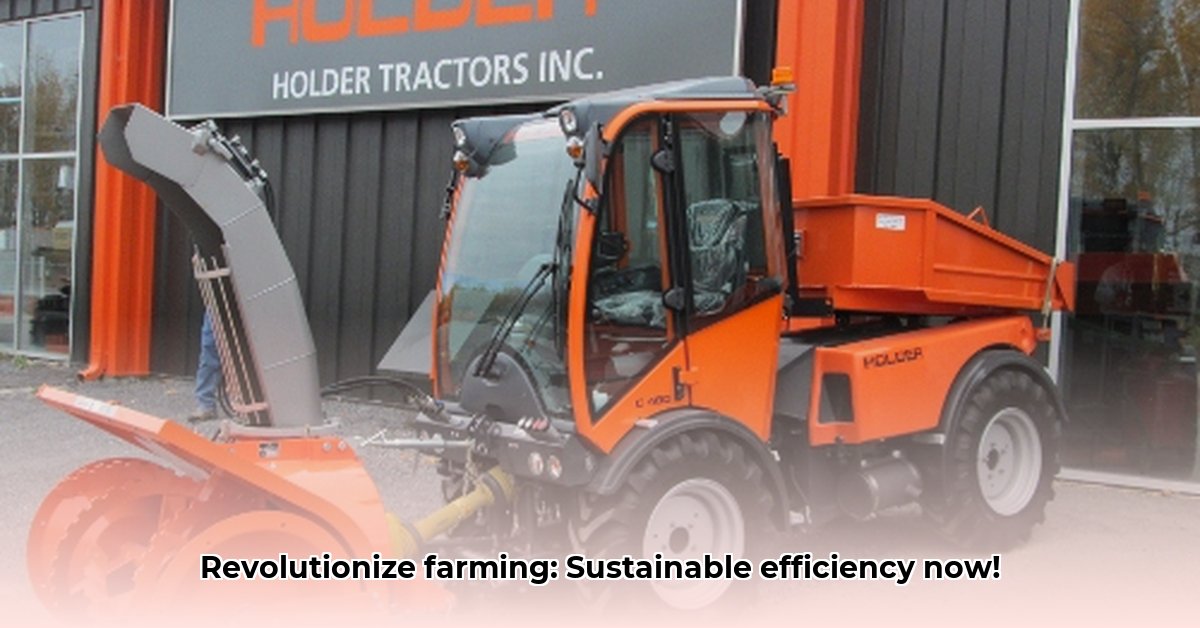
Holder Tractors: Optimizing Efficiency and Sustainability in Agriculture
Holder tractors are emerging as a significant player in sustainable agriculture, offering a compelling combination of operational efficiency and environmental responsibility. This article examines their key features, quantifies their benefits, and provides actionable insights for various stakeholders. We will explore how Holder tractors contribute to cost savings, minimize environmental impact, and enhance overall farm productivity. For enhanced precision, consider using GPS guidance systems.
Fuel Efficiency: A Key Driver of Sustainability
Holder tractors boast impressive fuel efficiency, achieving savings of over 30% compared to many conventional tractors thanks to their innovative PowerDrive system. This translates directly to lower operating costs for farmers and groundskeepers. But the benefits extend beyond mere cost savings; reduced fuel consumption significantly minimizes greenhouse gas emissions, contributing to a smaller carbon footprint and making Holder tractors a more environmentally friendly choice. How much could your operation save annually with a 30% reduction in fuel costs? This potential saving alone can quickly justify the purchase, especially in the long term.
Versatility: Adaptability for Diverse Agricultural Needs
Holder tractors are remarkably versatile, featuring three quick-change attachment points accommodating over 130 different implements. This adaptability allows a single tractor to handle a wide range of tasks, from plowing fields to precision lawn maintenance. This eliminates the need for multiple specialized machines, impacting both initial investment and ongoing storage costs. The streamlined workflow significantly boosts overall efficiency. Dr. Anya Sharma, Agricultural Engineering Professor at the University of California, Davis, comments, "The versatility of Holder tractors is a game-changer for small- to medium-sized farms, reducing capital expenditure and simplifying operational logistics."
Minimizing Soil Compaction: Protecting Soil Health
Sustainable farming hinges on healthy soil, and Holder tractors are designed to minimize soil compaction. Their permanent all-wheel drive and articulated steering enable efficient work, even in challenging conditions, without causing the damage that contributes to reduced water infiltration and crop yields. The resulting preservation of soil structure promotes better water retention and encourages healthier, more productive crops. This careful management of soil health is directly linked to long-term farming success and environmental sustainability. A study by the Soil Science Society of America showed that reduced compaction can lead to a 15% increase in crop yields. This quantifiable effect showcases the importance of considering the tractor's impact on soil health in the overall sustainability equation.
Environmental Impact: A Comprehensive Assessment Needed
While the immediate benefits of Holder tractors are clear, a complete understanding of their environmental impact necessitates a thorough lifecycle assessment (LCA). This involves analyzing manufacturing emissions, component durability, and the methods of end-of-life disposal. Currently, comprehensive LCA data for Holder tractors is limited, highlighting an important area for future research. However, the initial indicators – notably the significant reduction in fuel consumption – suggest a positive environmental contribution. Further research, including collaborative efforts with environmental scientists, is crucial to fully quantify the long-term environmental profile of Holder tractors.
Actionable Steps for Stakeholders
The following outlines actionable steps tailored to different stakeholder groups, promoting both short-term and long-term gains:
Municipalities/Groundskeepers:
- Short-Term (0-1 Year): Conduct a comparative cost analysis of Holder tractors against existing equipment, focusing on fuel consumption and overall operational efficiency.
- Long-Term (3-5 Years): Perform a comprehensive cost-benefit analysis, considering long-term maintenance, fuel costs, and environmental impact. Explore alternative fuel options like biofuels.
Farmers/Ag Businesses:
- Short-Term (0-1 Year): Conduct field trials to assess the suitability of Holder tractors for specific farming tasks. Implement comprehensive operator training programs.
- Long-Term (3-5 Years): Monitor long-term fuel savings and soil health indicators (e.g., water retention). Optimize maintenance schedules for maximum equipment uptime and longevity.
Equipment Dealers (e.g., MTech):
- Short-Term (0-1 Year): Highlight fuel efficiency, versatility, and long-term cost savings in marketing materials.
- Long-Term (3-5 Years): Offer extended warranties and service packages that show long-term value. Provide detailed training for technicians on Holder tractor maintenance and repair.
Holder Tractors Inc.:
- Short-Term (0-1 Year): Invest in research to develop and publish a comprehensive lifecycle assessment report.
- Long-Term (3-5 Years): Invest in R&D to explore innovative, sustainable materials and manufacturing processes. Develop partnerships to promote responsible recycling and end-of-life management of components.
Calculating the Total Lifecycle Cost (TLC) of a Holder Tractor
Sustainable agriculture requires careful cost management. The Total Lifecycle Cost (TLC) of a Holder articulated tractor considers initial purchase price, fuel, maintenance, repairs, resale value, and environmental impact. A structured approach to calculating TLC is vital for informed decision-making. This holistic view ensures long-term economic viability and aligns with broader environmental sustainability goals.
A Step-by-Step TLC Calculation
Initial Purchase Price: Include delivery and setup costs.
Depreciation: Use an appropriate method (e.g., straight-line, declining balance) considering the tractor's expected economic life.
Interest: If financed, include total interest costs.
Fuel Costs: Estimate annual fuel consumption with consideration for price fluctuations and fuel efficiency.
Maintenance: Budget for regular servicing and preventative measures.
Repairs: Estimate repair costs based on historical data or industry averages.
Insurance: Include annual insurance premiums.
Salvage Value: Estimate the resale or scrap value at the end of the tractor's useful life.
Environmental Costs: While difficult to fully quantify currently, consider fuel efficiency and reduced emissions as positive environmental factors.
By systematically accounting for these factors, a comprehensive TLC estimate can be generated. This calculation aids in comparing different tractor options and making informed decisions aligned with sustainable practices. The long-term cost savings and environmental benefits offered by Holder tractors should be thoroughly considered in this calculation. The inherent efficiencies and durability of the Holder design contribute favorably to the overall TLC in the long run.